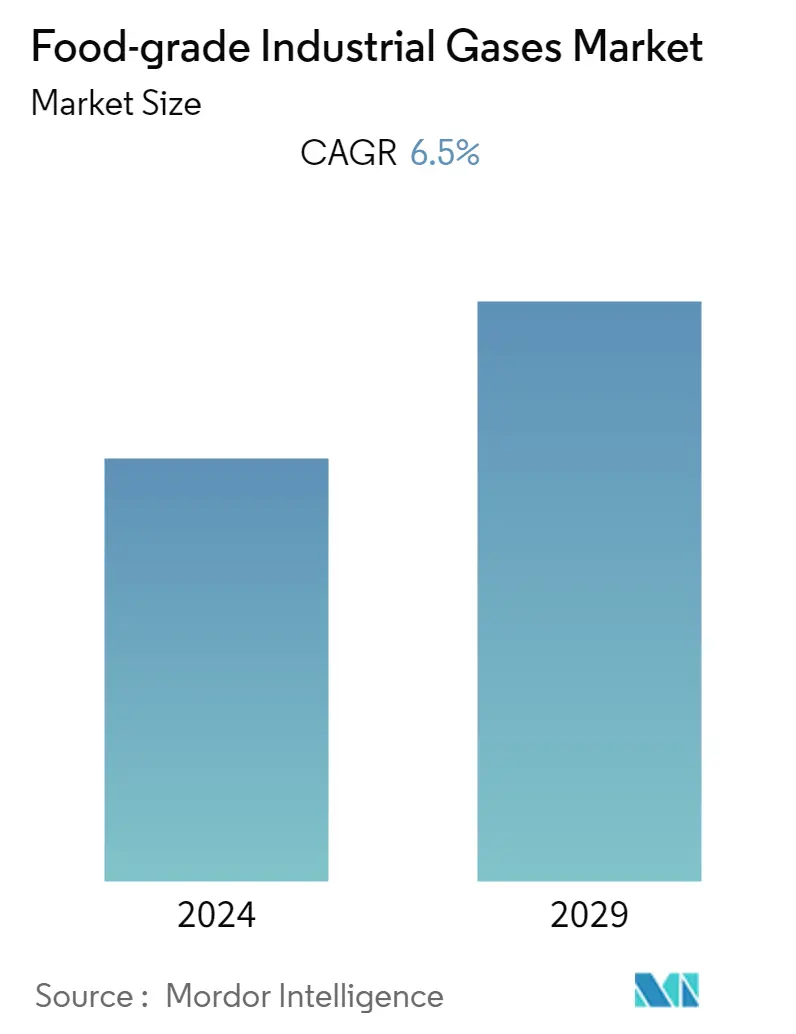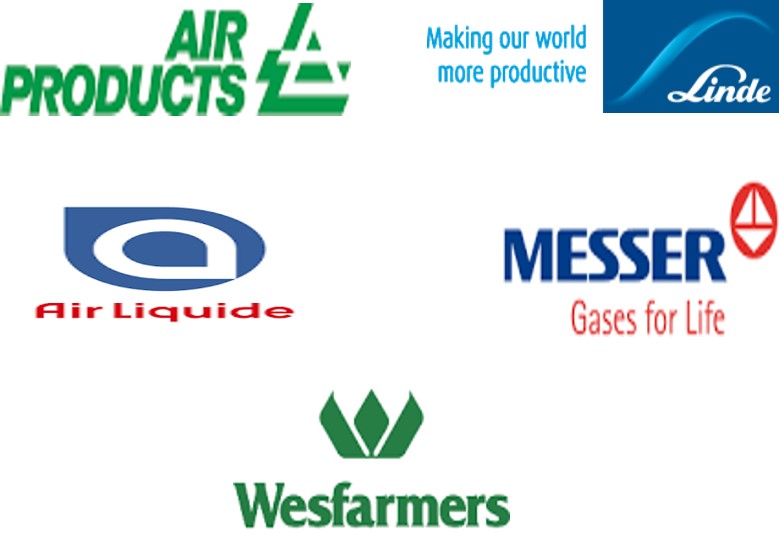Market Size of Food-grade Industrial Gases Industry

| Study Period | 2019 - 2029 |
| Base Year For Estimation | 2023 |
| CAGR | 6.50 % |
| Fastest Growing Market | Asia Pacific |
| Largest Market | North America |
| Market Concentration | High |
Major Players
*Disclaimer: Major Players sorted in no particular order |
Food Grade Industrial Gasses Market Analysis
The global food-grade industrial gases market is estimated to register a CAGR of 6.5% during the forecast period (2020-2025).
- The increasing demand for fresh products and packaged food has led to the use of industrial gases in the food and beverage sector. The increasing working hours and changing lifestyles have affected the growth of convenience or packaged food. This has resulted in the growth of packing technologies and frozen foods. Nitrogen, carbon dioxide, and oxygen are the major industrial gases that are used in various food applications, such as freezing, packaging, chilling, and grinding.
- Food-grade industrial gases are classified as processing aids or additives. Nitrogen is an innert gas and is extensively used to delay oxidative and hydrolytic rancidity in fat-rich foods. Carbon dioxide is used in cooling, freezing, modified atmosphere packaging, and carbonization. Higher concentrations of carbon dioxide (above 5%) effectively act as antimicrobial agents, thereby, delaying food spoilage.
- The companies are increasingly investing in packaging technologies that are free from synthetic preservatives, by replacing them with food-grade industrial gases. For example, Deccan Field Agro Industries from India utilized active modified atmosphere packaging (AMAP), in order to extend the shelf life of papaya by over four weeks and to export the fruit to Dubai.
Food Grade Industrial Gasses Industry Segmentation
The major industrial gases being used in the food and beverage industry include carbon dioxide, nitrogen, oxygen, and other types. Food-grade industrial gases play an important role in different products, such as beverages, meat, poultry, and seafood products, dairy and frozen products, bakery and confectionery products, fruits and vegetables, and others. The market report on industrial food-grade gases provides an outlook on the potential markets in each region.
Food-grade Industrial Gases Market Size Summary
The food-grade industrial gases market is experiencing significant growth, driven by the increasing demand for fresh and packaged food products. This demand is largely fueled by changing lifestyles and the need for convenience, which has led to advancements in packaging technologies and the rise of frozen foods. Key industrial gases such as nitrogen, carbon dioxide, and oxygen play crucial roles in various food applications, including freezing, packaging, chilling, and grinding. These gases act as processing aids or additives, helping to extend the shelf life of food products and maintain their quality without the use of synthetic preservatives. The adoption of modified atmosphere packaging (MAP) is particularly notable, as it preserves the freshness of organic and fresh food products, aligning with the global trend towards clean-label products.
In North America, the food-grade industrial gases market is poised for growth due to the rising demand from end-use industries like processed foods, bakery and confectionery, and breakfast cereals. The region's millennials, who prefer convenient food options, are driving the demand for packaged foods that require minimal preparation. Additionally, the trend of healthy snacks and the high per capita consumption of meat products further bolster the market. The competitive landscape is dominated by major players such as Linde PLC and Air Liquide SA, who are leveraging strategies like mergers, acquisitions, and product innovations to strengthen their market presence. These companies are also expanding their innovation centers to collaborate on new product developments, ensuring they remain at the forefront of the industry.
Food-grade Industrial Gases Market Size - Table of Contents
-
1. MARKET DYNAMICS
-
1.1 Market Drivers
-
1.2 Market Restraints
-
1.3 Porter's Five Forces Analysis
-
1.3.1 Threat of New Entrants
-
1.3.2 Bargaining Power of Buyers/Consumers
-
1.3.3 Bargaining Power of Suppliers
-
1.3.4 Threat of Substitute Products
-
1.3.5 Intensity of Competitive Rivalry
-
-
-
2. MARKET SEGMENTATION
-
2.1 By Type
-
2.1.1 Carbon Dioxide
-
2.1.2 Nitrogen
-
2.1.3 Oxygen
-
2.1.4 Other Types
-
-
2.2 By End-use Industry
-
2.2.1 Beverages
-
2.2.2 Meat, Poultry, and Seafood Products
-
2.2.3 Dairy and Frozen Products
-
2.2.4 Bakery and Confectionery Products
-
2.2.5 Fruits and Vegetables
-
2.2.6 Other End-use Industries
-
-
2.3 Geography
-
2.3.1 North America
-
2.3.1.1 United States
-
2.3.1.2 Canada
-
2.3.1.3 Mexico
-
2.3.1.4 Rest of North America
-
-
2.3.2 Europe
-
2.3.2.1 Spain
-
2.3.2.2 United Kingdom
-
2.3.2.3 France
-
2.3.2.4 Germany
-
2.3.2.5 Russia
-
2.3.2.6 Italy
-
2.3.2.7 Rest of Europe
-
-
2.3.3 Asia-Pacific
-
2.3.3.1 China
-
2.3.3.2 Japan
-
2.3.3.3 India
-
2.3.3.4 Australia
-
2.3.3.5 Rest of Asia-Pacific
-
-
2.3.4 South America
-
2.3.4.1 Brazil
-
2.3.4.2 Argentina
-
2.3.4.3 Rest of South America
-
-
2.3.5 Middle East and Africa
-
2.3.5.1 South Africa
-
2.3.5.2 Saudi Arabia
-
2.3.5.3 Rest of Middle East & Africa
-
-
-
Food-grade Industrial Gases Market Size FAQs
What is the current Food-grade Industrial Gases Market size?
The Food-grade Industrial Gases Market is projected to register a CAGR of 6.5% during the forecast period (2024-2029)
Who are the key players in Food-grade Industrial Gases Market?
Linde plc, Air Products & Chemicals, Inc., Air Liquide S.A., Messer Group and Wesfarmers Limited are the major companies operating in the Food-grade Industrial Gases Market.

